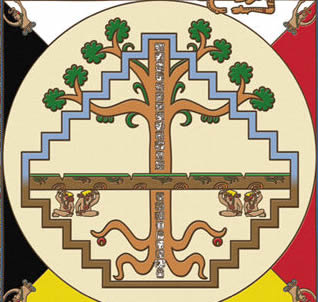Fiery Pool: The Maya and the Mythic Sea, is organized into four sections: “Water and Cosmos”; “Creatures of the Fiery Pool”; “Navigating the Cosmos”; and “Birth to Rebirth.” The Fiery Pool itself refers to a Mayan view of the world. Our earth, as the Mayans knew is, was imagined as a great turtle floating in the ocean. The shell or back of the turtle is what the Mayans thought was their land, their world. And the sun, rising in the east, setting in the west, was the Fiery Pool. We now know that for the Maya, water was a critical primordial element in all aspects of their lives. (The figurine pictured above is of the Jaguar God of the Underworld, riding upon a crocodile.)
For the Maya the turtle was associated with water, thunder and with the earth. The surface of the world was depicted as the back of a turtle. The Maya deity (Pauahtun) who supported the world on his shoulders is sometimes depicted wearing a turtle shell on his head and the Maize God is sometimes shown emerging from a turtle shell.
And so the Maya believed they rode upon "Turtle Island". This exhibit really touches on new territory, for while some Mayan cities were on the coastline, a vast majority were built inland, and giant cenotes were created to hold water for the cities. For a generally inland people, the discovery that they were obsessed with the sea is a surprising new fact.
When you take in the exhibit, which will travel on to Fort Worth and St. Louis, you will get to see a 10 foot tall cast from Belize, with three masks that represent Water Lily Serpent. Also a block of glyphs that seem to recount the travels of a Mayan King, who made a pilgrimage to the sea.
Above, Lidded bowl with the Iguana- Jaguar, from about 500AD
Lidded Vessel of a World Turtle
The wonderful exhibit runs till July 18th, and it is a rare chance to see pieces never displayed in the U.S. before.
THE FIERY POOL, THE MAYA AND THE MYTHIC SEA
PEABODY ESSEX MUSEUM
27 MARCH-18 JULY 2010
WWW.PEM.ORG
J.T. Turner, Mayanist










 Glyph of the sky
Glyph of the sky
